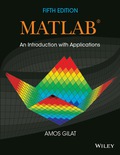
Concept explainers
The Maxwell-Boltzmann probability density
where m (kg) is the mass of each molecule, v (m/s) is the speed, T(K) is the temperature, and k = 1.38×10-23J/K is Boltzmann’s constant. The most probable speed vpcorresponds to the maximum value of f(v) and can be determined from
Want to see the full answer?
Check out a sample textbook solution
Chapter 11 Solutions
EBK MATLAB: AN INTRODUCTION WITH APPLIC
- The wind speed at a height of 10 meters at a location covered with crops (a = 0.20) is 5 !! m/s. What is the speed at a height of 50 m? Select one: O A. 5 m/s O B. 8.5 m/s O C. 6.9 m/sarrow_forwardJUSTLearn First Semester 2021 English (en) An automobile moving along a straight track changes its velocity from 40 m/s to 80 m/s in a distance of 800 m. What is the (constant) acceleration of the vehicle during this time in m/s? a. 8. b. 6. с. 4 d. O 1. d О 2.a O3. C O 4. b Next pagearrow_forwardhello, i’m studying coordinate system from electromagnetics. In the cartesian coordinate system, the coordinate variables x, y, and z are already length dimensions, so the scaling factors to convert them to length are hx=1, hy=1, and hz=1. In the cylindrical coordinate system, the scaling factors to convert the rho and z into length , are hrho=1 and hz=1. A) what is the hpi that changes coordinate pi into the length? B) in terms of spherical coordinates, what is the hr, htheta , hpi that changes ( r, theta, pi ) of spherical coordinate into the length?arrow_forward
- The intrinsic impedance of a medium is given by "1 impedance in free space is: Hint: -8.854x10¹ and μo -4m x 10' H/m 265 Q 48902 1920 377 0 -√ AQ.So the intrinsicarrow_forwardQ2) The position of a particle along a straight line is given by s = (1.5t - 13.5ť + 22.5t) ft, where t is in seconds. Determine the position, velocity, and acceleration of the particle when t 6 s and the total distance it travels during the 6-s time interval.arrow_forwardThe intrinsic impedance of a medium is given by 71 impedance in free space is: Hint: -8.854x10 and μo -4m x 10' H/m 2650 489 0 19202 377 0 Q.So the intrinsic Activate Windowsarrow_forward
- If the pole is located at the origin of the s plane, the response is in the form of a: a. damp exponential b. exponential rise c. sinusoid d. constant What characterizes an unstable system? a. poles at the origin b. poles with negative real part c. poles with positive real part d. poles without real part Routh’s stability criterion will provide the number of: a. RHP b. poles c. LHP d. imaginary polesarrow_forwardLet's say we imagine a motor. It seems that motor is a normal and relatively popular and very common. Let us say that this motor in particular has a shaft. This shaft that the motor is composed of is then turning at an anguler speed at the time when t is equal to 0. a = A + Bt after the times t= 0, we have In this case, A & B contain apprOpriate units. (rad/s) α (rad/s^2) :) WE NEED TO GET: a. We need to figure out what would be the angulor speed of this shaft that we are talking about at any t at all. b. We need to figure out what would be the alteration in angulor position of this shaft we are talking about that is relative to its t value for any t at all. c. let us imagine if the shaft that we are talking about has a radius (r of course), we need to figure out what will be the distances will a point on the edge of the shaft have traveler from t=0 to t. SORRY ENGLISH ISNT MY LANGUAGE! THANK YOU :)arrow_forwardOver a time interval of 1.83 years, the velocity of a planet orbiting a distant star reverses direction, changing from +18.4 km/s to -17.3 km/s. Find (a) the total change in the planet's velocity (in m/s) and (b) its average acceleration (in m/s2) during this interval. Include the correct algebraic sign with your answers to convey the directions of the velocity and the acceleration.arrow_forward
 Introductory Circuit Analysis (13th Edition)Electrical EngineeringISBN:9780133923605Author:Robert L. BoylestadPublisher:PEARSON
Introductory Circuit Analysis (13th Edition)Electrical EngineeringISBN:9780133923605Author:Robert L. BoylestadPublisher:PEARSON Delmar's Standard Textbook Of ElectricityElectrical EngineeringISBN:9781337900348Author:Stephen L. HermanPublisher:Cengage Learning
Delmar's Standard Textbook Of ElectricityElectrical EngineeringISBN:9781337900348Author:Stephen L. HermanPublisher:Cengage Learning Programmable Logic ControllersElectrical EngineeringISBN:9780073373843Author:Frank D. PetruzellaPublisher:McGraw-Hill Education
Programmable Logic ControllersElectrical EngineeringISBN:9780073373843Author:Frank D. PetruzellaPublisher:McGraw-Hill Education Fundamentals of Electric CircuitsElectrical EngineeringISBN:9780078028229Author:Charles K Alexander, Matthew SadikuPublisher:McGraw-Hill Education
Fundamentals of Electric CircuitsElectrical EngineeringISBN:9780078028229Author:Charles K Alexander, Matthew SadikuPublisher:McGraw-Hill Education Electric Circuits. (11th Edition)Electrical EngineeringISBN:9780134746968Author:James W. Nilsson, Susan RiedelPublisher:PEARSON
Electric Circuits. (11th Edition)Electrical EngineeringISBN:9780134746968Author:James W. Nilsson, Susan RiedelPublisher:PEARSON Engineering ElectromagneticsElectrical EngineeringISBN:9780078028151Author:Hayt, William H. (william Hart), Jr, BUCK, John A.Publisher:Mcgraw-hill Education,
Engineering ElectromagneticsElectrical EngineeringISBN:9780078028151Author:Hayt, William H. (william Hart), Jr, BUCK, John A.Publisher:Mcgraw-hill Education,





